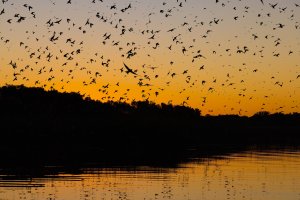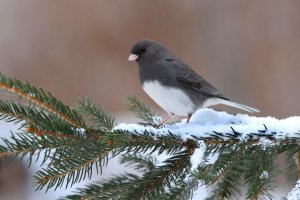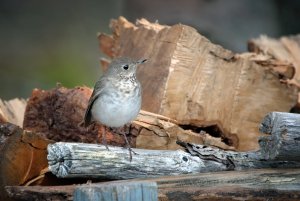Bird Migration
September 20, 2023
Making the Journey Southward- By Steve Dishman, Interpreter
Happy Autumn! As a lifelong lover of all things autumn, I have been awaiting the arrival of my favorite season. Of course, fall is more than enjoying an apple cider or pumpkin spice latte. Autumn is all about change. And in the animal kingdom, few groups do as much as birds.
With the changing of leaves and first frosts coming, many of Michigan’s bird species employ the best practice for their survival and take to the skies to fly south for the winter. Some of these migrations are relatively short, such as Canada Geese. Others fly thousands of miles, like the small Ruby-Throated Hummingbird. But why migrate? Can’t birds survive in Michigan instead of making a perilous trek?
Although many of Michigan’s bird species employ survival strategies to stay in Michigan, others just can’t. Dietary needs for some species, such as insectivores like Tree Swallows and Purple Martins, can’t be met in the frigid months.

Swallows and martins both eat insects on the wing. Purple Martins travel to South America to find an abundance of flying insects to eat, while Tree Swallows winter in Mexico and Central America. Purple Martins travel in groups so large that they even appear on weather radar!
Some may lament the departure of favorite birds like orioles, hummingbirds, and warblers, but there’s a bright side. Michigan becomes the winter home to several species of birds that breed and nest in Northern Canada and Alaska. A favorite of mine is the Dark-Eyed Junco. Juncos are in the New World sparrow family Passerellidae and Dark-Eyed Juncos have 14 or 15 subspecies! You will likely find a flock of Slate-Colored Dark-Eyed Juncos enjoying seed at your birdfeeder in the winter. Appropriately, a group of juncos is called a blizzard.

There are even bird species that merely fly over Michigan on their journey south. One of the most remarkable examples of this is the small Gray-Cheeked Thrush. In large groups, this remarkable thrush travels from its breeding grounds that range from Alaska to the northern parts of Quebec and Newfoundland to Brazil and Peru! It’s a remarkably long migration for a small songbird.

So how does a bird know to migrate? It’s a combination of factors. Generally speaking, natural cues like changing daylight, temperature, and food levels will signal the bird to move its location. Even first-year birds remarkably know how to find their way south. Many birds will flock together for migration, but other birds fly solo, relying on the sun, stars, and even Earth’s magnetic field to help them find their way. It is a perilous journey, too. Birds need to find food on their migration route to keep themselves healthy. But also, moving from one location to another can make them vulnerable to predation. To reduce the risk of predation, many birds migrate by night using the stars as navigation.
One bird species travel between the North and South Pole for migration: The Arctic Tern. They undergo such a long-distance migration to follow the sun. During Michigan’s winter, the sun is closer to the Southern Hemisphere, so Arctic Terns seek the polar summer temperatures by flying over 44,000 miles to Antarctica. More sunlight means more time to find their favorite prey items: namely insects and fish. It’s an unrivaled migration in the animal kingdom.
Want to get a closer look at bird migration? Visit one of your Metropark nature centers this fall, take to the trails to find some birds moving through! And of course, you may want to get your bird feeders ready to welcome some of these hungry travelers!
